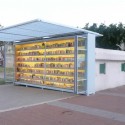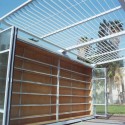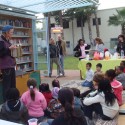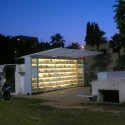Sticky Postings
All 242 fabric | rblg updated tags | #fabric|ch #wandering #reading
By fabric | ch
-----
As we continue to lack a decent search engine on this blog and as we don't use a "tag cloud" ... This post could help navigate through the updated content on | rblg (as of 09.2023), via all its tags!
FIND BELOW ALL THE TAGS THAT CAN BE USED TO NAVIGATE IN THE CONTENTS OF | RBLG BLOG:
(to be seen just below if you're navigating on the blog's html pages or here for rss readers)
--
Note that we had to hit the "pause" button on our reblogging activities a while ago (mainly because we ran out of time, but also because we received complaints from a major image stock company about some images that were displayed on | rblg, an activity that we felt was still "fair use" - we've never made any money or advertised on this site).
Nevertheless, we continue to publish from time to time information on the activities of fabric | ch, or content directly related to its work (documentation).
Wednesday, February 18. 2015
World Brain: a journey through data centers | #data #dimensions
Via iiclouds.org (Nicolas Nova)
-----
“World Brain” by Stéphane Degoutin and Gwenola Wagon (2015):
World Brain proposes a stroll through motley folkloric tales : data centers, animal magnetism, the Internet as a myth, the inner lives of rats, how to gather a network of researchers in the forest, how to survive in the wild using Wikipedia, how to connect cats and stones…
The world we live in often resembles a Borgesian story. Indeed, if one wanted to write a sequel to Borges’ Fictions, he could do it simply by putting together press articles.
The World Brain is made out mostly of found materials : videos downloaded on Youtube, images, scientific or pseudo scientific reports, news feeds… [...] World Brain takes the viewer through a journey inside the physical places by which the Internet transits: submarine cables, data centers, satellites. The film adopts the point of view of the data. The audience view the world as if they were information, crossing the planet in an instant, copied in an infinite number of instances or, at the contrary, stored in secret places.
Friday, January 23. 2015
Inhabiting and Interfacing the Cloud(s) – Talk & workshop at LIFT 15
Note: Following my recent posts about the research project "Inhabiting & Intercacing the Cloud(s)" I'm leading for ECAL, Nicolas Nova and I will be present during next Lift Conference in Geneva (Feb. 4-6 2015) for a talk combined with a workshop and a skype session with EPFL (a workshop related to the I&IC research project will be on the finish line at EPFL –Prof. Dieter Dietz’s ALICE Laboratory– on the day we’ll present in Geneva). If you plan to take part to Lift 15, please come say "hello" and exchange about the project.
Via the Lift Conference & iiclouds.org
—–
Inhabiting and Interfacing the Cloud(s)
Workshop description : Since the end of the 20th century, we have been seeing the rapid emergence of “Cloud Computing”, a new constructed entity that combines extensively information technologies, massive storage of individual or collective data, distributed computational power, distributed access interfaces, security and functionalism.
In a joint design research that connects the works of interaction designers from ECAL & HEAD with the spatial and territorial approaches of architects from EPFL, we’re interested in exploring the creation of alternatives to the current expression of “Cloud Computing”, particularly in its forms intended for private individuals and end users (“Personal Cloud”). It is to offer a critical appraisal of this “iconic” infrastructure of our modern age and its user interfaces, because to date their implementation has followed a logic chiefly of technical development, governed by the commercial interests of large corporations, and continues to be seen partly as a purely functional,centralized setup. However, the Personal Cloud holds a potential that is largely untapped in terms of design, novel uses and territorial strategies.
The workshop will be an opportunity to discuss these alternatives and work on potential scenarios for the near future. More specifically, we will address the following topics:
- How to combine the material part with the immaterial, mediatized part? Can we imagine the geographical fragmentation of these setups?
- Might new interfaces with access to ubiquitous data be envisioned that take nomadic lifestyles into account and let us offer alternatives to approaches based on a “universal” design? Might these interfaces also partake of some kind of repossession of the data by the end users?
- What setups and new combinations of functions need devising for a partly nomadic lifestyle? Can the Cloud/Data Center itself be mobile?
- Might symbioses also be developed at the energy and climate levels (e.g. using the need to cool the machines, which themselves produce heat, in order to develop living strategies there)? If so, with what users (humans, animals, plants)?
The joint design research Inhabiting & Interfacing the Cloud(s) is supported by HES-SO, ECAL & HEAD.
Interactivity : The workshop will start with a general introduction about the project, and moves to a discussion of its implications, opportunities and limits. Then a series of activities will enable break-out groups to sketch potential solutions.
Wednesday, January 15. 2014
Intel Edison: A Computer in an SD Card | #computing #everyware
Via Make
-----

Intel’s new single board computer, Edison, takes on a familiar form factor. Jammed into an SD card, the 400MHz Quark processor on board has two cores, flash memory, and includes Wi-Fi and Bluetooth Low Energy for communication. It runs Linux on one core and a real time operating system on the other. You can program Edison by inserting the board into the SD card reader of your computer. The pins on the bottom of the board are capable of GPIO, UART, I2C, SPI, and PWM. “It can be designed to work with most any device—not just computers, phones, or tablets, but chairs, coffeemakers, and even coffee cups,” according to Intel’s press release. “The possibilities are endless for entrepreneurs and inventors of all kinds.” At first glance, I think this could be a good board for makers as well.
Check out the video below for more about Intel’s newest dev board including some test implementations from Thomas Lipoma, the founder of Rest Devices, the makers of the Mimo baby monitor.
Thursday, September 13. 2012
How Google Builds Its Maps—and What It Means for the Future of Everything

It's common when we discuss the future of maps to reference the Borgesian dream of a 1:1 map of the entire world. It seems like a ridiculous notion that we would need a complete representation of the world when we already have the world itself. But to take scholar Nathan Jurgenson's conception of augmented reality seriously, we would have to believe that every physical space is, in his words, "interpenetrated" with information. All physical spaces already are also informational spaces.
-
Read the full press article on theatlantic.com
Personal comment:
Interesting point by author A. C. Madrigal in his article to consider the Google driverless cars as the coming "web crawlers" of the physical world ... Interesting also, the concept of "deep map".
Additionnal comment on this post (01.10.2012), even more interesting now that we see Google driverless cars getting legalized in California...
Tuesday, June 21. 2011
Discontinuous, contingent, and nontraditionally vulnerable
Check it out if you get a chance—and thanks again to Domus for the opportunity to explore this topic.

Personal comment:
Beside the topic that tells us that a country as a lot of distributed crucial interests outside its own borders, which modifies the idea of nation's territory, I also like the fact that it is shown on Buckminster Fuller's map that describes an Earth made out of connected and nearly continuous lands and archipelagoes, connected through the Arctic...
Monday, May 02. 2011
Landform Building
Even if this is rather a riding area and playground for moutain bikers (or such) underneath a highway (see below the glacier image), it can give us additionnal ideas toward a sort of "architecture as landscape" approach. We consider "architecture as landscape" a different type of variable environment: it is not the infrastructure that evolves (robotized and heavy approach), but the light, the weather, the (networked, mediated or computed) conditions, the creolization and spatial interferences.
Similar to a landscape where climate and context evolve and where you "freely" migrate within, depending on the conditions and your activity or needs. A sort of Sanaa's Rolex Learning Center, but diy approach.
I'm also therefore taking the occasion to mention this new book about a similar topic:
Landform Building, Lars Müller Publishing

Thanks to @BLDGBLOG for the following link, via F.A.D. (Free Association Design)
-----
Circuits Beneath the Freeway

[flow lines of ramps, berms, drops and various home-spun earth retaining systems beneath the I-5 freeway]
While in Seattle this past weekend I had the chance to make a brief stop by the city’s Colonnade Park. Given it’s size, I managed to cover about half of the accentuated terrain (on foot) built into the underbelly of the I-5.

The brilliance of the park’s siting becomes obvious when you are immersed in it: the steep and jumbled topography; the formerly barren and listless ground in the shadow of the overpass; the industrial cathedral that serves as ready-made shelter for the 9-out-of-12 soggy months of the Northwest climate; and perhaps the most critical factor – the challenges and indifference towards such spaces – which allowed for it to be co-opted into something else equally unique and unpolished.
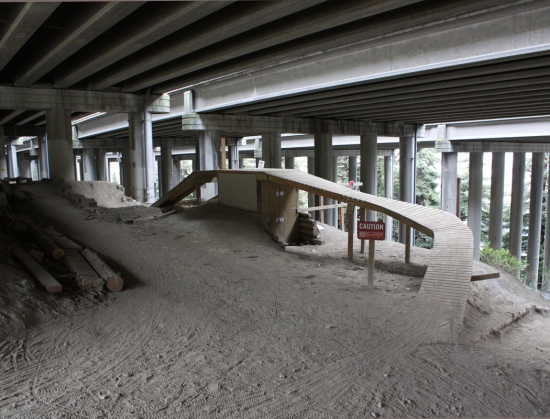
[storage shed built into a ramp and elevated planks]

It hard not to be enamored by the successful and improvised gestalt of the whole thing, in both program and materials. Much of what it is made of was donated or recycled from demolition projects around the city. And typical off-the-shelf items, like permeable waffle pavers (above), have been retooled as robust and removable cellular confinement systems. All the pieces of the circuits have this hand-made, custom quality that is site + multiple user specific.





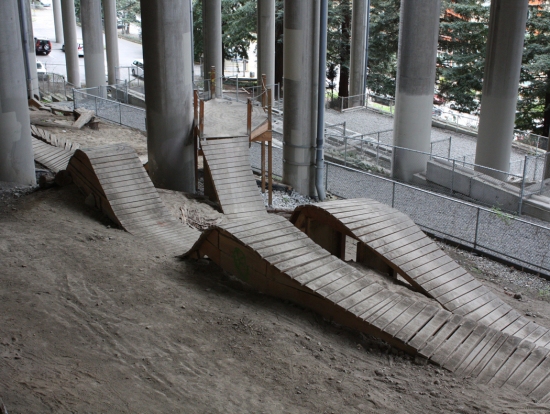 One comes away with the impression that the park will keep remaking itself incrementally, over and over again. Pieces and segments will be modified as they wear out, with new experiments being plugged in as desired. It seems that the builders and volunteers that have constructed it might actually be a little forlorn if the park were ever fully finished.
One comes away with the impression that the park will keep remaking itself incrementally, over and over again. Pieces and segments will be modified as they wear out, with new experiments being plugged in as desired. It seems that the builders and volunteers that have constructed it might actually be a little forlorn if the park were ever fully finished.

Related Links:
Monday, February 21. 2011
The Garden Library for Refugees and Migrant Workers
Via ArchDaily
-----
by Andrew Rosenberg

© R.Kuper
Architects: Yoav Meiri Architects
Location: Tel Aviv, Israel
Client: Arteam – Interdisciplinary Art Team
Project area: 50 sqm
Project year: 2010
Photographs: Y.Meiri, R. Kuper, T. Rogovski
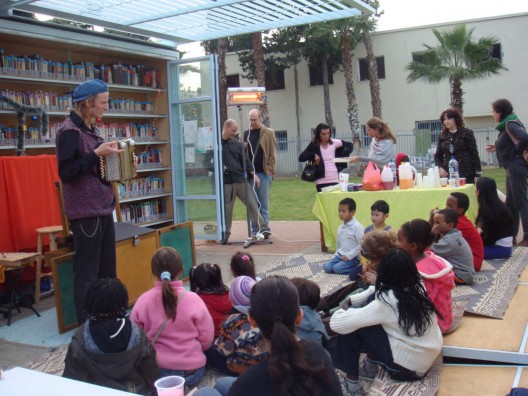
© Y.Meiri
The Garden Library for Refugees and Migrant Workers was founded in 2010 as a social-artistic urban community project. The project sees the right to a book as a fundamental human right and a possibility of both escape and shelter from daily misfortunes.
The library is located in the Levinski Park, by the Tel Aviv central bus station. The park is the place migrant workers congregate on weekends. It was important for us that the library come to the people, that those who maintain illegal immigrant status will come without fear, that the library would not have a closed door or a guard at the entrance who would check and ask questions.

diagram 01
The library has no walls or door. It is comprised of two bookcases, which are supported by the walls of a public shelter located in the heart of the park. The taller structure contains books for the adult readers. It is transparent and illuminated from within so that, at night, the books glow in the park. Across from it is a shorter – children’s height – cabinet. The doors to the small cabinet swing down to form a parquet floor for the children to sit on and review the books.

© T.Rogovski
The door of the tall cabinet, open to form a canopy that stretches above the two structures, and provides shelter from the sun and rain, protects the books and the visitors, and establishes a space for browsing, reading and social meetings.
The library contains approximately 3,500 books in Mandarin Chinese, Amharic, Thai, Tagalog, Arabic, French, Spanish, Nepalese, Bengali, Hindi, Turkish, Romanian, and English. The children’s cabinet also holds books in Hebrew.

© Y.Meiri
The books are not catalogued according to conventions of genre or author name, but according to the feeling they arouse. Every detail in the sorting and categorization system reflects the spirit of the library: The library is a small and parallel world: the books wander between the shelves as their readers have wandered/are wandering the world. They carry with them their emotional history. The placement of the book is not decided by popular vote, but by the last reader. Even if ten readers thought a book was amusing and the eleventh thought it was dull, the book will move to the Boring shelf – at least until the next reader weighs in.
Related Links:
Personal comment:
Beside the fact that we can enjoy to see a constructive project regarding migration and migrant people (so to say: not some stupid propaganda and populism), I also find interesting on a more trivial or spatial aspect the mashup between two public programs: the parc and the library.
Tuesday, October 26. 2010
Christian Marclay: The Clock

As engaging as it is an excellent concept, The Clock is the latest video installation by Christian Marclay now on at the White Cube Mason’s Yard. A chronological collage that pieces film footage into a twenty-four hour clock, using the illusionary devices that carry you through the duration of a cinematic narrative – characters checking watches, dramatic shots of a clock on the mantle piece, etc – by localising the time zone of a fictional event, it’s as if fantasy is replaced with real time.
Related Links:
Friday, October 22. 2010
Ludlow 38 presents Maryanne Amacher's City-Links
Via Art-Agenda
-----
Ludlow 38 is pleased to present the exhibition Maryanne Amacher: City-Links. Between 1967 and 1981 the pioneering sound artist produced 22 City-Links projects in total, connecting distant microphones to installations and performances using dedicated FM-quality analog phone lines. Areas of downtown Buffalo, MIT, Boston Harbor, the Mississippi River, the New York harbor, studios in various locations, and other sites in the USA and abroad were transported, sometimes integrating performers near the microphones (such as John Cage and George Lewis for City-Links #18 performed at The Kitchen in 1979). The exhibition at Ludlow 38 brings together a number of documents, images and sound samples selected and reproduced from the nascent Amacher Archive as a first look at this important series of early telematic art works about which little has been published.
Maryanne Amacher wrote about her City-Links series: In my first sound works I developed the idea of sonic telepresence, introducing the use of telecommunication in sound installations. In the telelink installations "CITY-LINKS" #1-22 (1967- ) the sounds from one or more remote environment (in a city, or in several cities) are transmitted "live" to the exhibition space, as an ongoing sonic environment. I produce the "CITY-LINKS" installations using real-time telelinks to transmit the sound from microphones I place in the selected environments, spatializing these works with many different sonic environments: harbors, steel mills, stone towers, flour mills, factories, silos, airports, rivers, open fields, utility companies, and with musicians "on location." The adventure is in receiving live sonic spaces from more than one location at the same time - the tower, the ocean, the abandoned mill. Remote sound environments enter our local spaces and become part of our rooms. Instal lations of "CITY-LINKS" include works created for solo and group shows at the Museum of Contemporary Art, Chicago (1974); Walker Arts Center "Projected Images," Minneapolis (1974); Hayden Gallery MIT, "Interventions In Landscape," Cambridge, Mass (1975); Institute of Contemporary Art, Boston, Mass. (1975); Corps de Garde, Groningen, Holland (1978); the Kitchen Center, NYC (1979); Radio France Musique (1976); Mills College (1980 & 1994).
Maryanne Amacher was born on February 25, 1938 in Kane, PA and died October 22, 2009 in Rhinebeck, NY. At Maryanne Amacher's urging The Amacher Archive was initiated by her friends Robert The and Micah Silver during her illness in the summer of 2009. For more information or to support the project: maryanneamacher.org
A tribute to Maryanne Amacher will be held on the first anniversary of her death, October 22, 2010 and is organized and hosted by the MIT Program in Art, Culture and Technology in Cambridge, MA.
Maryanne Amacher: City-Links has been curated by Tobi Maier, Micah Silver, Robert The and Axel Wieder.
---
Maryanne Amacher
City-Links
October 21 – November 28, 2010
Opening:
Wednesday October 20, 6-8pm
Ludlow 38 Künstlerhaus Stuttgart Goethe-Institut New York
38 Ludlow Street
New York 10002
Tel. 212 228 6848
info@ludlow38.org
Gallery hours: Thursday – Sunday 1-6pm and
by appointment
www.ludlow38.org
---
Related Links:
Personal comment:
Sound telepresence. Sounds "usual" today, but it must be underlined that Amacher's works, City-Links (this could be the title of one of our work today!), date back from the 70ies. And where one more time, we see the Name of John Cage pop up...
fabric | rblg
This blog is the survey website of fabric | ch - studio for architecture, interaction and research.
We curate and reblog articles, researches, writings, exhibitions and projects that we notice and find interesting during our everyday practice and readings.
Most articles concern the intertwined fields of architecture, territory, art, interaction design, thinking and science. From time to time, we also publish documentation about our own work and research, immersed among these related resources and inspirations.
This website is used by fabric | ch as archive, references and resources. It is shared with all those interested in the same topics as we are, in the hope that they will also find valuable references and content in it.
Quicksearch
Categories
Calendar
|
|
July '25 | |||||
| Mon | Tue | Wed | Thu | Fri | Sat | Sun |
| 1 | 2 | 3 | 4 | 5 | 6 | |
| 7 | 8 | 9 | 10 | 11 | 12 | 13 |
| 14 | 15 | 16 | 17 | 18 | 19 | 20 |
| 21 | 22 | 23 | 24 | 25 | 26 | 27 |
| 28 | 29 | 30 | 31 | |||



